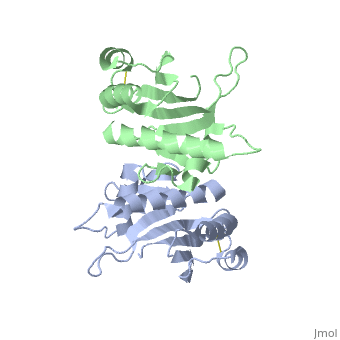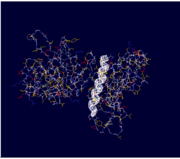Pilin
From Proteopedia
(Difference between revisions)
| (4 intermediate revisions not shown.) | |||
| Line 2: | Line 2: | ||
==Introduction== | ==Introduction== | ||
| - | '''Pilin''' (PIL) or '''fimbrial protein''' is a fibrous protein found in the pilus of bacteria. Pili in bacteria are used for exchange of DNA during bacterial conjugation. Type IV pili play an important role in the pathogenesis of many bacterial species; they are a required component for the adhesion of bacteria to their target cells. For example, Type IV pili are required for infection by the pathogens that cause cholera, typhoid, pneumonia, gonorrhea, and meningitis. <ref name=journal1>PMID:19626704</ref> They may also mediate transformation, modulate target-cell specificity and play a role in twitching motility. PilS is a protein that is a member of the pilin protein superfamily. <ref name=journal2>Asha M. Balakrishna,Yvonne Yih-Wan Tan, Henry Yu-Keung Mok,Anand M. Saxena,and Kunchithapadam Swaminathan. Crystallization and preliminary X-ray diffraction analysis of Salmonella typhi PilS. 2006 October 1; 62(Pt 10): 1024–1026</ref> | + | '''Pilin''' (PIL) or '''fimbrial protein''' is a fibrous protein found in the pilus of bacteria. Pili in bacteria are used for exchange of DNA during bacterial conjugation. '''Type IV pili''' play an important role in the pathogenesis of many bacterial species; they are a required component for the adhesion of bacteria to their target cells. For example, Type IV pili are required for infection by the pathogens that cause cholera, typhoid, pneumonia, gonorrhea, and meningitis. <ref name=journal1>PMID:19626704</ref> They may also mediate transformation, modulate target-cell specificity and play a role in twitching motility. PilS is a protein that is a member of the pilin protein superfamily. <ref name=journal2>Asha M. Balakrishna,Yvonne Yih-Wan Tan, Henry Yu-Keung Mok,Anand M. Saxena,and Kunchithapadam Swaminathan. Crystallization and preliminary X-ray diffraction analysis of Salmonella typhi PilS. 2006 October 1; 62(Pt 10): 1024–1026</ref> |
==Structure== | ==Structure== | ||
| - | Type IV pilin are homopolymers, composed of a single-chain pilin protein. The first common element that all type IVb pilins contain is the inclusion of the C-terminal β-strand (β7 in PilS) in the center of the structure, forming an antiparallel arrangement. <ref name=journal1>PMID:19626704</ref> A conserved 25 residue hydrophobic N terminal sequence, that serves as an oligomerization domain for fibre formation, is shared by all type IV pilins. Finally, all pilins also share a conserved pilus assembly machinery, a unique N-methylated N-terminus and a pair of conserved cysteines that form an intrachain disulphide bond. The type IVb pilus operon of ''S. typhi'' contains the piLS gene, which encodes a structural pilin. <ref name=journal1>PMID:19626704</ref> | + | Type IV pilin are homopolymers, composed of a single-chain pilin protein called '''major pilin''' and a less abundant protein called '''minor pilin''' which are essential for the pilus assembly and function<ref name=journal1>PMID:31784891</ref>. The first common element that all type IVb pilins contain is the inclusion of the C-terminal β-strand (β7 in PilS) in the center of the structure, forming an antiparallel arrangement. <ref name=journal1>PMID:19626704</ref> A conserved 25 residue hydrophobic N terminal sequence, that serves as an oligomerization domain for fibre formation, is shared by all type IV pilins. Finally, all pilins also share a conserved pilus assembly machinery, a unique N-methylated N-terminus and a pair of conserved cysteines that form an intrachain disulphide bond. The type IVb pilus operon of ''S. typhi'' contains the piLS gene, which encodes a structural pilin. <ref name=journal1>PMID:19626704</ref> |
The cysteine-containing region in the C-terminus is thought to play a function via the formation of disulfides in CFTR adhesion and in the assembly of PilS to make the pilus of the bacterium. The highly conserved N-terminal hydrophobic tail functions as a oligomerization domain for fibre formation. <ref name=journal2>Asha M. Balakrishna,Yvonne Yih-Wan Tan, Henry Yu-Keung Mok,Anand M. Saxena,and Kunchithapadam Swaminathan. Crystallization and preliminary X-ray diffraction analysis of Salmonella typhi PilS. 2006 October 1; 62(Pt 10): 1024–1026</ref> The D-region of the type IVb pilins is known to contain residues that function in pilus assembly; this region is stabilized by a conserved disulfide bond. <ref name=journal1>PMID:19626704</ref> | The cysteine-containing region in the C-terminus is thought to play a function via the formation of disulfides in CFTR adhesion and in the assembly of PilS to make the pilus of the bacterium. The highly conserved N-terminal hydrophobic tail functions as a oligomerization domain for fibre formation. <ref name=journal2>Asha M. Balakrishna,Yvonne Yih-Wan Tan, Henry Yu-Keung Mok,Anand M. Saxena,and Kunchithapadam Swaminathan. Crystallization and preliminary X-ray diffraction analysis of Salmonella typhi PilS. 2006 October 1; 62(Pt 10): 1024–1026</ref> The D-region of the type IVb pilins is known to contain residues that function in pilus assembly; this region is stabilized by a conserved disulfide bond. <ref name=journal1>PMID:19626704</ref> | ||
| Line 18: | Line 18: | ||
==Function== | ==Function== | ||
| - | Type IV pili are diverse in function; they mediate numerous cellular functions via their polymeric machinery. These functions include cell adhesion, signalling, phage attachment, surface motility, biofilm formation and DNA uptake by natural transformation. Specifically, the type IVb pilus of ''Salmonella typhi'' is the adhesion factor that allows the pathogen to enter into the gastrointestinal cells of humans with ease. The first step in ''S.typhi'' pathogenesis is the type IVb pilus self-mediated self-association in the anerobic human small intestine preceding the entry into the human intestine epithelium. <ref name=journal1>PMID:19626704</ref> | + | '''Type IV pili''' are diverse in function; they mediate numerous cellular functions via their polymeric machinery. These functions include cell adhesion, signalling, phage attachment, surface motility, biofilm formation and DNA uptake by natural transformation. Specifically, the type IVb pilus of ''Salmonella typhi'' is the adhesion factor that allows the pathogen to enter into the gastrointestinal cells of humans with ease. The first step in ''S.typhi'' pathogenesis is the type IVb pilus self-mediated self-association in the anerobic human small intestine preceding the entry into the human intestine epithelium. <ref name=journal1>PMID:19626704</ref> |
A proposed prerequisite for CFTR binding is the dimer formed in the symmetrical subunit of PilS. <ref name=journal2>Asha M. Balakrishna,Yvonne Yih-Wan Tan, Henry Yu-Keung Mok,Anand M. Saxena,and Kunchithapadam Swaminathan.Crystallization and preliminary X-ray diffraction analysis of Salmonella typhi PilS. 2006 October 1; 62(Pt 10): 1024–1026</ref> The type IVb PilS protein binds to a 15-mer peptide that corresponds to the first extracellular domain of the human cystic fibrosis transmembrane regulator (an epithelial chloride channel) in the INT407 cell membrane. PilS contains a binding pocket in the region where the CFTR peptide is attached to the protein. <ref name=journal1>PMID:19626704</ref> The surface around this active site pocket is slightly positively charged because of the presence of Lys75, Lys120, and Arg 169. This means it is able to effectively bind the negatively charged CFTR peptide. Residues 113-117 of CFTR are crucial for the S. typhi pilus binding and Glu115 and Glu116 of the peptide are involved in binding to the PilS protein.<ref name=journal1>PMID:19626704</ref> | A proposed prerequisite for CFTR binding is the dimer formed in the symmetrical subunit of PilS. <ref name=journal2>Asha M. Balakrishna,Yvonne Yih-Wan Tan, Henry Yu-Keung Mok,Anand M. Saxena,and Kunchithapadam Swaminathan.Crystallization and preliminary X-ray diffraction analysis of Salmonella typhi PilS. 2006 October 1; 62(Pt 10): 1024–1026</ref> The type IVb PilS protein binds to a 15-mer peptide that corresponds to the first extracellular domain of the human cystic fibrosis transmembrane regulator (an epithelial chloride channel) in the INT407 cell membrane. PilS contains a binding pocket in the region where the CFTR peptide is attached to the protein. <ref name=journal1>PMID:19626704</ref> The surface around this active site pocket is slightly positively charged because of the presence of Lys75, Lys120, and Arg 169. This means it is able to effectively bind the negatively charged CFTR peptide. Residues 113-117 of CFTR are crucial for the S. typhi pilus binding and Glu115 and Glu116 of the peptide are involved in binding to the PilS protein.<ref name=journal1>PMID:19626704</ref> | ||
PilS causes typhoid by entering the enterocytes and specialized M cells of the small intestine. After entry, it is transferred to the intestinal submucosa and is taken up by host macrophages. The overall mechanism of the entry into the enterocytes is complicated and involves intercellular adhesins and intracellular signaling which change the host cell's vacuolar and cytoskeletal organization. <ref name=journal1>PMID:19626704</ref> | PilS causes typhoid by entering the enterocytes and specialized M cells of the small intestine. After entry, it is transferred to the intestinal submucosa and is taken up by host macrophages. The overall mechanism of the entry into the enterocytes is complicated and involves intercellular adhesins and intracellular signaling which change the host cell's vacuolar and cytoskeletal organization. <ref name=journal1>PMID:19626704</ref> | ||
| - | + | ||
== 3D Structures of pilin == | == 3D Structures of pilin == | ||
| + | [[Pilin 3D structures]] | ||
| - | + | </StructureSection> | |
| - | + | ||
| - | + | ||
| - | + | ||
| - | + | ||
| - | + | ||
| - | + | ||
| - | + | ||
| - | + | ||
| - | + | ||
| - | + | ||
| - | + | ||
| - | + | ||
| - | + | ||
| - | + | ||
| - | + | ||
| - | + | ||
| - | + | ||
| - | + | ||
| - | + | ||
| - | + | ||
| - | + | ||
| - | + | ||
| - | + | ||
| - | + | ||
| - | + | ||
| - | + | ||
| - | + | ||
| - | + | ||
| - | + | ||
| - | + | ||
| - | + | ||
| - | + | ||
| - | + | ||
| - | + | ||
| - | + | ||
| - | + | ||
| - | + | ||
| - | + | ||
| - | + | ||
| - | + | ||
| - | + | ||
| - | + | ||
| - | + | ||
| - | + | ||
| - | + | ||
| - | + | ||
| - | + | ||
| - | + | ||
| - | + | ||
| - | + | ||
| - | + | ||
| - | + | ||
| - | + | ||
| - | + | ||
== Additional Resources== | == Additional Resources== | ||
Current revision
| |||||||||||
Additional Resources
To See additional information, see: Bacterial Infections
References
- ↑ 1.00 1.01 1.02 1.03 1.04 1.05 1.06 1.07 1.08 1.09 1.10 1.11 Balakrishna AM, Saxena AM, Mok HY, Swaminathan K. Structural basis of typhoid: Salmonella typhi type IVb pilin (PilS) and cystic fibrosis transmembrane conductance regulator interaction. Proteins. 2009 Nov 1;77(2):253-61. PMID:19626704 doi:10.1002/prot.22500
- ↑ 2.0 2.1 2.2 Asha M. Balakrishna,Yvonne Yih-Wan Tan, Henry Yu-Keung Mok,Anand M. Saxena,and Kunchithapadam Swaminathan. Crystallization and preliminary X-ray diffraction analysis of Salmonella typhi PilS. 2006 October 1; 62(Pt 10): 1024–1026
Proteopedia Page Contributors and Editors (what is this?)
Michal Harel, Elyse Yaremco, David Canner, Andrea Gorrell, Alexander Berchansky


